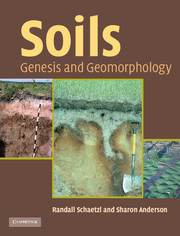Book contents
- Frontmatter
- Contents
- Preface
- Acknowledgements
- Part I The building blocks of the soil
- Part II Soil genesis: from parent material to soil
- Part III Soil geomorphology
- 13 Soil geomorphology and hydrology
- 14 Soil development and surface exposure dating
- 15 Soils, paleosols and paleoenvironmental reconstruction
- 16 Conclusions and Perspectives
- References
- Glossary
- Index
14 - Soil development and surface exposure dating
from Part III - Soil geomorphology
- Frontmatter
- Contents
- Preface
- Acknowledgements
- Part I The building blocks of the soil
- Part II Soil genesis: from parent material to soil
- Part III Soil geomorphology
- 13 Soil geomorphology and hydrology
- 14 Soil development and surface exposure dating
- 15 Soils, paleosols and paleoenvironmental reconstruction
- 16 Conclusions and Perspectives
- References
- Glossary
- Index
Summary
Soils and soil data can help determine the age of geomorphic surfaces (e.g., Mahaney 1984, Amit et al. 1996). In this regard, a soil can be no older than the deposit within which it formed, or the last period of stability of the geomorphic surface upon which it formed. That is, if a surface has undergone several periods of instability and stability, the current soil on it probably had its timezero no earlier than the onset of the last period of stability. Other soils on, or related to, that surface would have been either buried or eroded by earlier periods of instability (Butler 1959).
To determine the actual length of time that the soil may have been forming, one must first establish the age of the surface. This is usually done using geochronometric techniques such as radiocarbon dating or tephrochronology. Given enough pedogenic data, information regarding the amount of time required for certain soil properties to develop, or to be lost, begins to emerge. Armed with this knowledge, a soil geomorphologist can then use soil properties to provide reasonable estimates of the ages of other surfaces, for which strict geochronometric control is lacking. Thus, the first step in a soil geomorphic study is to ascertain what is known about the geologic past, what the main temporal markers are, and the duration and starting points of the soilforming intervals, i.e., when surfaces were stable.
Colman et al. (1987) pointed out the need for consistency in terminology among those using dating techniques in soils and geomorphology, and we agree.
- Type
- Chapter
- Information
- SoilsGenesis and Geomorphology, pp. 547 - 618Publisher: Cambridge University PressPrint publication year: 2005



